Composite decking has become an increasingly popular choice for homeowners looking to build or renovate their outdoor living spaces. Made from a blend of wood fibers and recycled plastic, composite deck boards are touted for their durability, low maintenance, and natural wood-like appearance.
Two of the biggest brand names in composite decking are NewTechWood and Trex. But when it comes to choosing between NewTechWood vs. Trex, which option truly stands out?
In this comprehensive guide, we’ll compare and contrast NewTechWood and Trex composite decking across a variety of factors. We’ll look at the materials each are made from, available colors/styles, warranties, pricing, and real user reviews.
By the end, you’ll have all the details you need to decide whether NewTechWood or Trex is the better fit for your decking project.
A Brief Comparison Table
Before diving into the details, here is a high-level overview of how NewTechWood and Trex composite decking compare:
| Feature | NewTechWood | Trex |
| Main Material | Wood plastic composite (WPC) | Capstock shell over wood-plastic composite core |
| Texture | Wood grain finish | Wood grain or grooved finish |
| Colors | 8 natural wood colors | 7 natural wood colors |
| Stain Resistance | Good | Excellent |
| Scratch Resistance | Moderate | Very good |
| Warranty | 25 years residential, 10 years commercial | 25 years residential, 10 years commercial |
| Price Per Square Foot | $3.50 – $6.50 | $2.30 – $4.69 |
As you can see, there are some clear similarities but also key differences that set these two composite decking brands apart. Keep reading as we explore each factor in more detail.
Composite Decking Materials of NewTechWood And Trex Decking
One of the biggest differences between NewTechWood and Trex lies in the materials used to manufacture the deck boards.
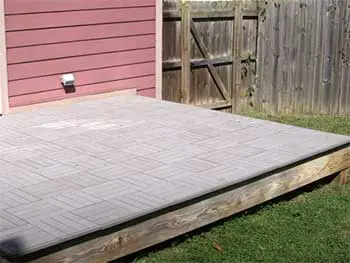
NewTechWood decking is made from wood plastic composite (WPC).
This blend generally contains 60-70% recycled wood fibers mixed with 30-40% recycled HDPE plastic.
During production, the wood fibers and plastic are extruded together to form solid deck boards.
Trex, on the other hand, uses what is called a capstock or shell design. The core of Trex decking is made from a similar WPC as NewTechWood. But Trex adds an extra layer – a protective polymer shell that fully encapsulates the core.
This capstock shell gives Trex enhanced stain, scratch, and fade resistance compared to other composites.
When it comes to durability, the capstock shell is a standout feature that gives Trex an advantage over the single extrusion design of NewTechWood. Independent lab testing has shown Trex to have superior resistance to abrasion, staining, and denting compared to leading WPC brands.
That said, NewTechWood decking still performs well in these areas. While not quite as resilient as Trex, NewTechWood offers good stain and fade resistance along with a resilient finish. So both deliver excellent low-maintenance performance that homeowners expect from composite.
Comparison of Appearance: Colors, Styles & Texture
When shopping for composite decking, you’ll want to consider the available color options, grain patterns, and surface textures. These features impact the appearance of your finished deck and how closely the boards resemble real wood.
Colors
Both NewTechWood and Trex offer a wide range of natural wood tones to match any style.
NewTechWood has 8 color options across their product lines:
- Walnut
- Light Grey
- Silver Grey
- Winchester Grey
- Brazilian Walnut
- Tigerwood
- Teak
- Ebony
Trex also has 7 natural wood colors:
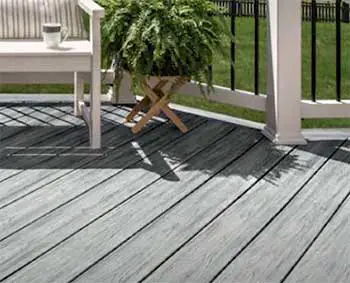
- Madeira
- Pebble Grey
- Saddle
- Tiki Torch
- Spiced Rum
- Lava Rock
- Island Mist
The color palettes are quite similar between the two brands, with light greys, warm browns, and richer reddish browns.
Both give you plenty of choice whether you want a light and modern or traditional wood-stained look.
One difference is that NewTechWood offers Ebony, an extremely dark charcoal color. This dramatic blackish tone is unique compared to the color options from Trex.
Grain Patterns
NewTechWood uses an embossed wood grain texture on their deck boards to emulate the look of real wood. The grain pattern gives the boards an authentic appearance that matches the colors.
Trex offers two finish options: wood grain or grooved. Their wood grain patterns are very realistic and comparable to NewTechWood. And their grooved boards have subtle striations for a more contemporary, streamlined look compared to straight wood grains.
So when it comes to grain, both deliver attractive and believable wood-like finishes. Trex just gives you a choice between traditional wood grain versus grooved depending on your aesthetic tastes.
Surface Texture
Along with the embossed wood grain, NewTechWood boards have a lightly grooved or striated surface texture. This helps improve grip and mimics the feel of real wood.
Trex also has lightly textured surfaces on their wood grain boards. The grooved boards have a smooth finish.
Overall, both offer surfaces that are comfortable to walk on barefoot but not overly gritty. NewTechWood aims for a more pronounced texture while Trex grains are subtler.
Stain & Scratch Resistance Comparison

An advantage of composite decking is the durability and low maintenance compared to natural wood. But the level of stain and scratch resistance can vary based on the quality of materials and finish.
As covered earlier, Trex has a strong advantage when it comes to stain resistance. The polymer capstock completely seals the wood-plastic core, creating an impenetrable barrier against spills, dirt, and debris.
Trex is virtually stain-proof, outperforming other composites in third-party staining tests.
NewTechWood still performs very well, with the wood-plastic construction resisting stains much better than real timber. But the core is not 100% sealed like Trex so very stubborn stains can occasionally soak in over time.
Light cleaning is recommended after spills or dirt buildup.
For scratch resistance, Trex again has the upper hand. The tough polymer shell is highly resilient against scrapes, scuffs, and surface damage from pets or furniture. Scratches tend to blend away over time. Independent scratch tests rate Trex above leading WPC brands.
NewTechWood is reasonably scratch-resistant, but the single extruded core can show light marks over the years. The textured grain pattern helps disguise light scuffs. But deep gouges or scratches may be permanent.
So for the most bulletproof stain and scratch protection, Trex is the winner thanks to the proprietary capstock shell. But NewTechWood still performs admirably for low maintenance.
Weight Load & Structural Performance
An important consideration for any decking is the strength and load ratings. You want boards that can handle weight and wear-and-tear without sagging, denting, or cracking.
Both NewTechWood and Trex composites deliver excellent structural performance that meets or exceeds timber. Some key ratings:
- NewTechWood boards boast a US concentrated static load rating of 550 lb per square inch. They exceed a code body concentrated load of 440 lb per square inch when installed correctly.
- Trex decking carries an impressive weight rating of 550 lb per square inch for the grooved boards and 700 lb per square inch for their wood grain boards.
So both brands deliver codes-approved strength and durability. Trex offers an even higher maximum load rating on their wood grain products. But for typical residential use, NewTechWood and Trex can both handle family gatherings, outdoor furniture, hot tubs, and other deck demands. Proper joist spacing is key for optimal performance.
When it comes to impact resistance, Trex’s capstock shell gives it the advantage again. The boards are highly dent-resistant and recover well from dropped objects. NewTechWood can show light indentations or markings under heavy impacts that may persist.
For ideal durability underload, Trex is the top performer. But NewTechWood still provides ample strength for residential decks under normal use and reasonable wear-and-tear.
Slip Resistance Comparison
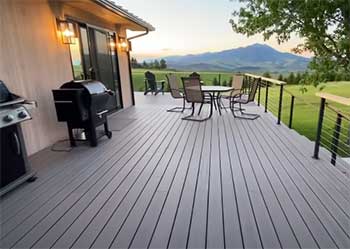
Slip resistance is another key decking performance metric, indicating the traction level underfoot.
This is especially important when building pool decks or other areas that will get wet.
NewTechWood and Trex boards both deliver sufficient grip when dry or wet:
- NewTechWood decking provides a slip resistance rating of 0.89 per DIN 51130 standards. This indicates good anti-slip traction.
- Independent British slip testing (BS 7976) shows Trex boards averaging a low-slip risk PTN 56+ when wet. They meet safety standards for outdoor flooring applications.
So whether deciding between NewTechWood vs Trex, both provide ample traction even when damp. The embossed wood grain textures give the needed friction under bare feet in any weather. Proper board spacing also promotes drainage and drying to maintain slip resistance.
While NewTechWood has a slightly higher slip score, the surface traction of both brands is suitable for pool decks or other wet areas. Neither fully eliminates risk when soaking wet, so caution is still advised.
Comparison of Heat Resistance
Excessive heat can be a concern for any decking over time. Composite boards contain plastic and need to withstand UV rays and the sun’s heat without deforming.
NewTechWood and Trex both use high-grade weather-resistant plastics in their composite make-up. This makes the boards far more heat-resistant than natural wood.
However, Trex may have a slight edge in heat performance. The polymer cap on Trex boards allows less heat transfer to the core compared to NewTechWood’s single extrusion. Under extreme hot and sunny conditions, Trex experiences less expansion/contraction and is less likely to get overly hot underfoot.
But even NewTechWood excels in heat stability compared to timber. Their wood-plastic boards require less heat ventilation and hold up well in sunny southern climates. Proper shade and airflow will maintain cooler temperatures for any composite deck boards.
So both NewTechWood and Trex will outlast real wood in the sun and heat. But Trex’s protective shell gives it the best heat management of these two brands.
Comparison of Cold Weather Performance
Along with heat, composites need to withstand freezing winter temperatures in colder climates. The key is minimizing contraction that can cause cracking or splitting.
Again, both NewTechWood and Trex are highly resistant to cold and frost compared to natural timber. Their composite construction makes them denser and less prone to major shrinking or expansion.
However, the capstock layer of Trex boards helps prevent moisture penetration into the cores. This results in less cold contraction and thermal movement vs NewTechWood’s open WPC core.
Under extreme cold, Trex may have a slight performance advantage. But both composites can handle freezing winters remarkably well vs wood. Proper ventilation and drainage is still key. Annual cleaning to remove debris also prevents excessive water pooling and freeze damage regardless of brand.
Warranties Comparison of NewTechWood And Trex
A strong warranty backing any composite decking provides peace of mind on your investment. Here is how the warranties compare between NewTechWood and Trex:
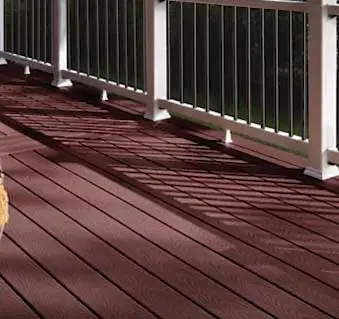
- NewTechWood offers a 25-year residential warranty and 10-year light commercial warranty. This covers defects in materials and workmanship that compromise structure and performance. Staining and scratching are not covered, nor is improper installation or maintenance.
- Trex provides an identical 25-year residential and 10-year commercial warranty. Structural damage is covered, while surface wear, staining, damages from acts of nature, and improper care are excluded.
So in terms of warranty duration under normal use, NewTechWood and Trex are on par – 25 years for residential and 10 years for commercial installations.
As standard industry warranties, make sure to read all terms for limitations and proper care/maintenance that can affect coverage.
An area where Trex pulled ahead was offering “true” stain and fade protection under their warranty for 10 years residential and 5 years commercial. While NewTechWood covers product defects well, they make no warranties regarding staining or sun damage.
Cost Comparison
When evaluating different composite decking brands, cost and budget play a key role. Let’s break down how NewTechWood and Trex compare on pricing:
NewTechWood Prices:
- Hollow boards: $3.50 – $4.50 per square foot
- Solid boards: $5.50 – $6.50 per square foot
Trex Prices:
- Enhance boards: $2.30 – $3.24 per square foot
- Transcend boards: $3.24 – $4.69 per square foot
As you can see, NewTechWood’s cost per square foot runs $1 to $2 above Trex depending on the specific products compared. NewTechWood occupies a more premium price point overall.
Keep in mind that prices vary by local distributors. And you must factor in full installed costs, not just materials. But based on retail decking prices alone, NewTechWood is 20-50% more expensive than Trex boards.
The higher prices of NewTechWood may reflect the improved stain/scratch resistance and luxury visuals from the Trex capstock shell. But feature-for-feature, Trex provides excellent durability and appearance at a more affordable price point for most budgets.
Reviews: What Real Homeowners Are Saying
Along with lab testing and warranties, real user reviews can provide helpful insight into how composite decking performs in the real world. Here are some key feedback highlights on NewTechWood vs. Trex:
NewTechWood
- Owners praise the attractive natural wood aesthetics. Colors and wood grain texture get positive marks for looking realistic and “not fake”.
- While durable, some users note scratches and dents do occur more than expected. Staining is also cited as a concern.
- Complaints of some warping in very hot or cold weather. Expansion/contraction issues noted by some customers.
- Labor for installation gets mixed feedback in reviews. Some find NewTechWood boards relatively easy to work with while others report minor difficulties.
Trex
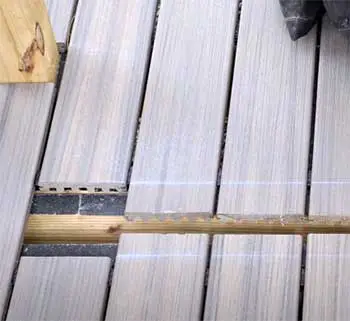
- One of Trex’s biggest advantages seems to be stain resistance. Many reviewers comment on spilled wine, grease, dirt, etc. wiping right off easily.
- Durability gets high marks, with the outer shell protecting well against scrapes, dents, and surface issues even after years.
- Minor contracting/expansion issues noted in very extreme cold or hot temps, but less than other composites.
- Reviews confirm Trex costs more upfront but praise the quality and long-term value for the money.
Overall, Trex earns outstanding reviews for low-maintenance, unbeatable stain resistance, and lasting beauty.
NewTechWood gets positive feedback but shows a few more durability concerns mentioned versus Trex. Both score well on appearance, though Trex looks marginally more realistic according to some users.
Frequently Asked Questions (FAQ)
While Trex is one of the top-rated and best-selling composite decking brands, a few alternatives may surpass Trex in certain areas:
1. TimberTech AZEK boards use a unique mineral-enriched polymer cap that provides enhanced fade and scratch resistance.
2. CertainTeed EverNew offers exceptional impact resistance and durability ratings exceeding Trex.
MoistureShield Vision outset Trex in independent lab testing for stain resistance and has excellent thermal performance.
Overall though, Trex remains a benchmark for durability, aesthetics, and warranty backing. For an all-around low maintenance composite at a reasonable price, Trex is hard to beat.
Some comparable alternatives to NewTechwood include:
1. TimberTech PRO Reserve: offers similar natural colors and premium price point as NewTechwood.
2. Cali Bamboo Grove: features solid bamboo composite core for environmental sustainability.
3. Wolf Serenity Decking: provides high-end visuals and colors along with excellent warranty.
Each of these mimic the upscale appearance and quality of NewTechWood while differing slightly in materials and technology. They make good alternatives for homeowners prioritizing luxury aesthetics in a composite.
TimberTech tends to be priced 20-30% higher than comparable Trex products. For example, TimberTech PRO Reserve boards run $5.50 to $7.50 per square foot installed while Trex Transcend costs $4.20 to $5.70 per square foot.
The higher prices of TimberTech reflect proprietary technologies like their mineral-enriched polymer caps for enhanced protection. So you pay a premium, but gain advantages in fade, stain, and scratch resistance compared to Trex. Overall though, Trex delivers excellent durability and performance at a more affordable cost for most homeowners’ budgets.
The primary raw materials used to manufacture NewTechWood decking are:
1. Recycled wood fibers: Approximately 60-70% of the boards consist of reclaimed hardwood material sourced from furniture factories, pallets, and other wood waste sources. The wood lends natural aesthetics and resilience.
2. HDPE plastic: Around 30% of the composite comes from post-consumer recycled plastic such as milk jugs, detergent bottles, and plastic bags. This increases durability and weather-resistance.
3. Pigments: Colorants are added to achieve the natural wood tone colors throughout the NewTechWood lines.
4. Additives: Specialty chemicals and lubricants are used when processing the raw materials into finished deck boards.
During production, all the ingredients above are precisely blended, melted, and extruded together under extreme heat and pressure. This fuses the wood fibers and plastic into durable, weather-resistant decking. The result is an eco-friendly, luxurious composite alternative to natural timber.
Conclusion & Recommendation
Based on comparing all the factors – from materials to warranties, aesthetics to real user reviews – Trex stands out as the best overall choice between these two quality composite decking brands.
While NewTechWood performs well in most areas and offers gorgeous visuals, Trex edges them out with:
- Superior stain and scratch resistance from the protective polymer capstock
- Slightly better durability against impacts, heat, and cold weather extremes
- More affordable pricing for budget-conscious homeowners
- Stellar reviews confirming easier care and maintenance
That said, NewTechWood is still an excellent product backed by a 25-year warranty. The rich colors and natural wood grains lend beauty and luxury to any deck.
For homeowners wanting the ultimate in low-maintenance composites, Trex is worth the extra investment. But you can’t go wrong with NewTechWood either if seeking high-end, elegant visuals at a fair price.
Taking the time to fully compare NewTechWood and Trex across the spectrum of features ensures you select the ideal composite to achieve your dream outdoor oasis. Let the information above guide you towards a long-lasting, gorgeous deck tailored to your needs and style.

